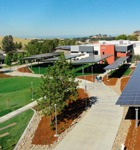The Scene
On 250 acres in the middle of a 928-acre wildlife refuge near Oroville, California, Butte-Glenn Community College has become one of the first schools in the country to go grid-positive. The rural college, which was established in 1966 and has a long history of sustainable operations—including maintaining its own water system—remains on the grid, but its 55 solar arrays generate all the electricity used by on-site facilities on a cost basis, and they also generate power for several off-site, leased facilities.

Butte-Glenn Community College, sequestered on a 900-acre wildlife refuge, generates all its own energy. Its solar arrays generate enough electricity for the school’s 100-plus buildings.
The Setup
The building’s local grid acts as a battery for the college, storing electricity generated during the day to be used at night, explains Michael Miller, director of facilities planning and management. Before completion in August 2011, the project spent 13 months in development, and Miller says the biggest challenge was the financing. In addition to accepting a local bond of $85 million, the college leveraged additional funding from the state to expend a total of $205 million on a mix of new construction, modernization, and energy-conservation efforts—coupled with energy generation to create the grid-positive campus.
The Strategy
Coordinating the construction required significant effort; the sprawling campus comprises more than 100 buildings, including 20 major structures, and its electricity feeds from 13 different meters on different buildings. Some building work was done at night to avoid class disturbance, but daytime work was unavoidable, which led to a few campus-wide power outages and some walking-path rerouting due to sidewalk upgrades.
BY THE NUMBERS
55
Number of solar arrays powering the grid-positive campus
928
Acreage of the California wildlife refuge the college calls home
800,000
Combined square footage of the school’s 100-plus buildings
One of the major goals for the project was to place the 55 solar arrays in proximity to the buildings without making spaces ugly and unusable for students and faculty. The result? Shade structures made of light- to medium-gauge galvanized steel—with solar panels on top—that now provide adequate coverage over parking areas, walkways, gathering spaces, and spectator areas on sports fields. “This gives us the benefit of clean energy and a reduction of the heat-island effect,” Miller says. He adds that an especially unique
element is the monitoring system installed on all arrays, which measures real-time cumulative data and a host of other factors. “The biggest problem with solar projects in the past was monitoring, but this has an auto-dial feature, so even if there’s a minor problem, we are automatically notified,” he says.
Building orientation, glazing, and shading were also important. Miller points to the college’s new arts building as an example, noting that painting and drawing classes required particular qualities of light that would be different from the indirect light needed in computer labs. Appropriate technology—such as the standardized occupancy sensors tied to the HVAC systems in all the new facilities—had to be adopted to meet the variety of the school’s 100-plus buildings, which total more than 800,000 square feet of space. Modulated multizones, direct-indirect evaporative precoolers, individualized split systems, high-efficiency carousel units, and variable drives have also been incorporated.
Early on, the college set project standards to exceed Title 24 energy requirements by at least 15 percent, and ultimately it was able to maximize energy-efficient design for all new buildings and retrofits. The resulting structures now play host to a student population of 14,000 or more each year—without ever placing heavy demand on an outside electrical grid.

